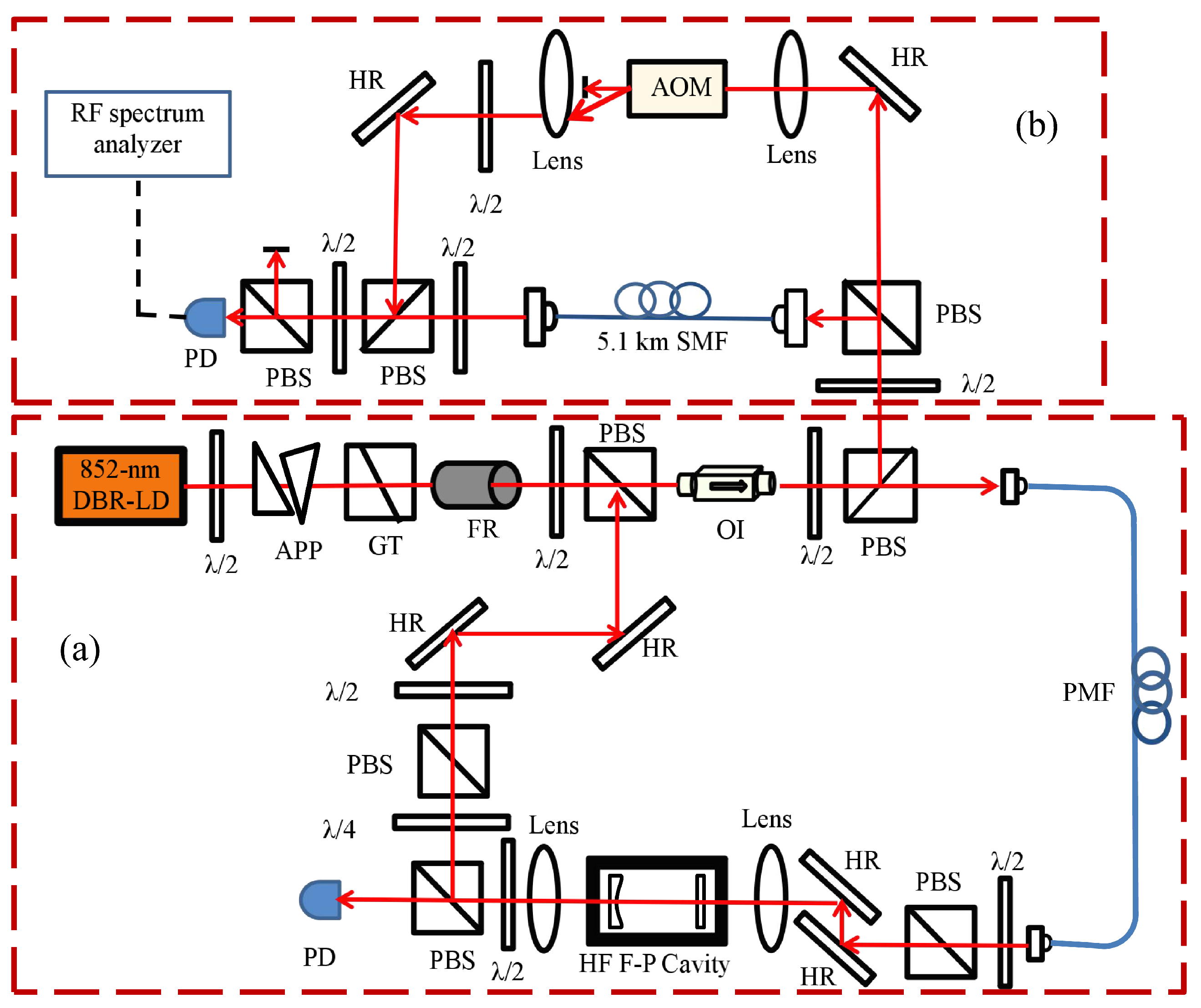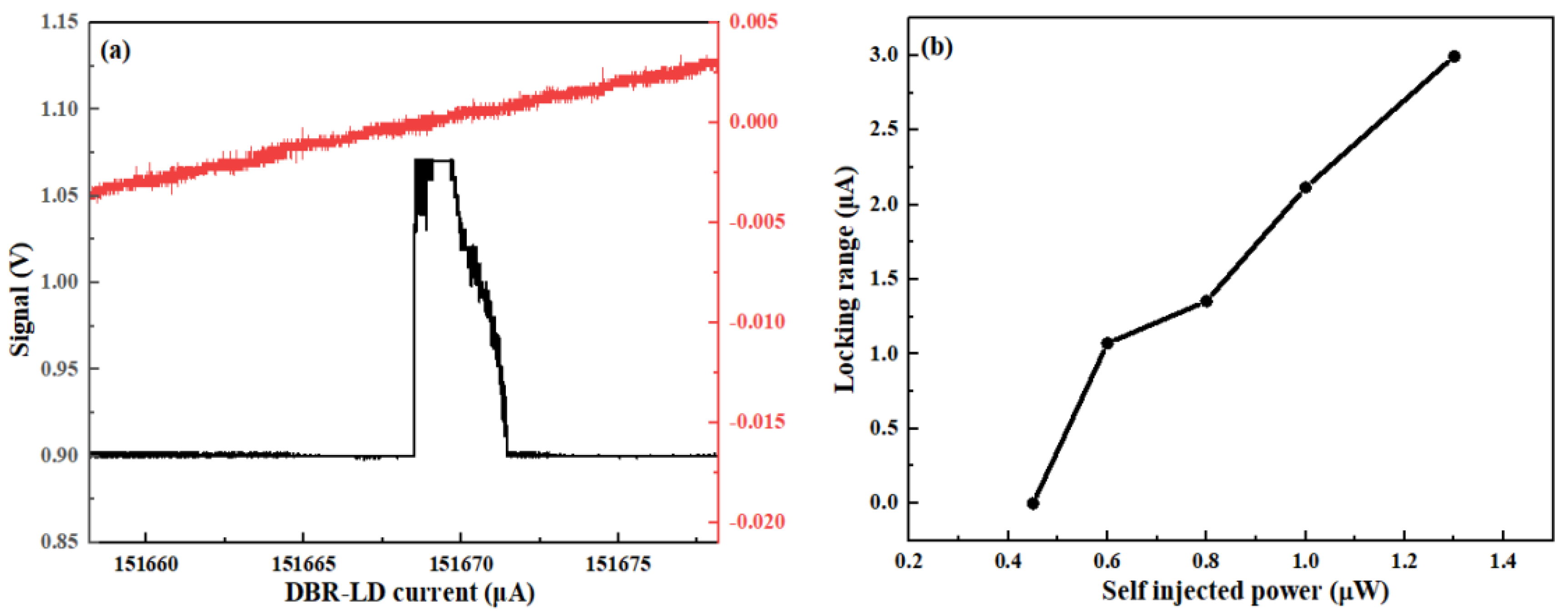Narrow-Linewidth 852-nm DBR-LD with Self-Injection Lock Based on High-Finesse Optical Cavity Filtering
Abstract
:1. Introduction
2. Experimental Principle
2.1. Self-Injection Lock of the Laser Diode
2.2. The Delayed Frequency-Shifted Self-Heterodyne (DFSSH) Method for Laser Linewidth Measurement
2.3. The Detuned F-P Cavity Method for Laser Phase Noise Measurement
3. Experimental Setup
4. Experimental Results
4.1. DBR-LD Laser Linewidth of the Free Running and Self-Injection Lock Case
4.2. The Laser Linewidth versus the Self-Injected Laser Power of the DBR-LD
4.3. The Self-Injection Locking Current Range of the DBR-LD versus the Self-Injected Laser Power
4.4. Measurement of the Laser Phase Noise
5. Conclusions
Author Contributions
Funding
Data Availability Statement
Conflicts of Interest
References
- Wieman, C.E.; Hollberg, L. Using diode lasers for atomic physics. Rev. Sci. Instrum. 1991, 62, 1–20. [Google Scholar] [CrossRef]
- Corato-Zanarella, M.; Gil-Molina, A.; Ji, X.C.; Shin, M.C.; Mohanty, A.; Lipson, M. Widely tunable and narrow-linewidth chip-scale lasers from near-ultraviolet to near-infrared wavelengths. Nat. Photonics 2023, 17, 157–164. [Google Scholar] [CrossRef]
- Inaba, H.; Hosaka, K.; Yasuda, M.; Nakajima, Y.; Iwakuni, K.; Akamatsu, D.; Okubo, S.; Kohno, T.; Onae, A.; Hong, F.L. Spectroscopy of 171Yb in an optical lattice based on laser linewidth transfer using a narrow linewidth frequency comb. Opt. Express 2013, 21, 7891–7896. [Google Scholar] [CrossRef]
- Nicholson, T.L.; Martin, M.J.; Williams, J.R.; Bloom, B.J.; Bishof, M.; Swallows, M.D.; Campbell, S.L.; Ye, J. Comparison of two independent 88Sr optical clocks with 1*10−17 stability at 103 s. Phys. Rev. Lett. 2012, 109, 230801. [Google Scholar] [CrossRef]
- Labaziewicz, J.; Richerme, P.; Brown, K.R.; Chuang, I.L. Compact, filtered diode laser system for precision spectroscopy. Opt. Lett. 2007, 32, 572–574. [Google Scholar] [CrossRef]
- Zeng, Y.; Xu, P.; He, X.D.; Liu, Y.Y.; Liu, M.; Wang, J.; Papoular, D.J.; Shlyapnikov, G.V.; Zhan, M.S. Entangling two individual atoms of different isotopes via Rydberg blockade. Phys. Rev. Lett. 2017, 119, 160502. [Google Scholar] [CrossRef]
- Crowe, J.W.; Craig, R.M. GaAs laser linewidth measurements by heterodyne detection. Appl. Phys. Lett. 1964, 5, 72–74. [Google Scholar] [CrossRef]
- Lang, R.; Kobayashi, K. External optical feedback effects on semiconductor injection laser properties. IEEE J. Quant. Electron. 1980, 16, 347–355. [Google Scholar] [CrossRef]
- Fleming, M.; Mooradian, A. Spectral characteristics of external-cavity controlled semiconductor lasers. IEEE J. Quant. Electron. 1981, 17, 44–59. [Google Scholar] [CrossRef]
- Tarallo, M.G.; Poli, N.; Schioppo, M.; Sutyrin, D.; Tino, G.M. A high-stability semiconductor laser system for a 88Sr-based optical lattice clock. Appl. Phys. B 2011, 103, 17–25. [Google Scholar] [CrossRef]
- Ludlow, A.D.; Huang, X.; Notcutt, M.; Zanon-Willette, T.; Foreman, S.M.; Boyd, M.M.; Blatt, S.; Ye, J. Compact, thermal-noise-limited optical cavity for diode laser stabilization at 1*10−15. Opt. Lett. 2007, 32, 641–643. [Google Scholar] [CrossRef]
- Lewoczko-Adamczyk, W.; Pyrlik, C.; Häger, J.; Schwertfeger, S.; Wicht, A.; Peters, A.; Erbert, G.; Tränkle, G. Ultra-narrow linewidth DFB-laser with optical feedback from a monolithic confocal Fabry-Perot cavity. Opt. Express 2015, 23, 9705–9709. [Google Scholar] [CrossRef] [PubMed]
- Döringshoff, K.; Ernsting, I.; Rinkleff, R.H.; Schiller, S.; Wicht, A. Low-noise, tunable diode laser for ultra-high-resolution spectroscopy. Opt. Lett. 2007, 32, 2876–2878. [Google Scholar] [CrossRef]
- Black, E.D. An introduction to Pound–Drever–Hall laser frequency stabilization. Am. J. Phys. 2001, 69, 79–87. [Google Scholar] [CrossRef]
- Drever, R.W.P.; Hall, J.L.; Kowalski, F.V.; Hough, J.; Ford, G.M.; Munley, A.J.; Ward, H. Laser phase and frequency stabilization using an optical resonator. Appl. Phys. B 1983, 31, 97–105. [Google Scholar] [CrossRef]
- Legaie, R.; Picken, C.J.; Pritchard, J.D. Sub-kilohertz excitation lasers for quantum information processing with Rydberg atoms. J. Opt. Soc. Am. B 2018, 35, 892–898. [Google Scholar]
- Liu, Y.Y.; Fu, Z.; Xu, P.; He, X.D.; Wang, J.; Zhan, M.S. Spectral filtering of dual lasers with a high-finesse length-tunable cavity for rubidium atom Rydberg excitation. Chinese Phys. B 2021, 30, 074203. [Google Scholar] [CrossRef]
- Jiang, Y.Y.; Bi, Z.Y.; Xu, X.Y.; Ma, L.S. Two-hertz-linewidth Nd: YAG lasers at 1064 nm stabilized to vertically mounted ultra-stable cavities. Chinese Phys. B 2008, 17, 2152. [Google Scholar]
- Alnis, J.; Matveev, A.; Kolachevsky, N.; Udem, T.; Hänsch, T.W. Subhertz linewidth diode lasers by stabilization to vibrationally and thermally compensated ultralow-expansion glass Fabry-Pérot cavities. Phys. Rev. A 2008, 77, 053809. [Google Scholar] [CrossRef]
- Xue, C.P.; Ji, S.K.; Wang, A.B.; Jiang, N.; Qiu, K.; Hong, Y.H. Narrow-linewidth single-frequency photonic microwave generation in optically injected semiconductor lasers with filtered optical feedback. Opt. Lett. 2018, 43, 4184–4187. [Google Scholar] [CrossRef]
- Zhao, Y.; Li, Y.; Wang, Q.; Meng, F.; Lin, Y.G.; Wang, S.K.; Lin, B.K.; Cao, S.Y.; Cao, J.P.; Fang, Z.J.; et al. 100-Hz linewidth diode laser with external optical feedback. IEEE Photon. Technol. Lett. 2012, 24, 1795–1798. [Google Scholar] [CrossRef]
- Liang, W.; Liu, Y.F. Compact sub-hertz linewidth laser enabled by self-injection lock to a sub-milliliter FP cavity. Opt. Lett. 2023, 48, 1323–1326. [Google Scholar] [CrossRef] [PubMed]
- Bohlouli-Zanjani, P.; Afrousheh, K.; Martin, J.D.D. Optical transfer cavity stabilization using current-modulated injection-locked diode lasers. Rev. Sci. Instrum. 2006, 77, 093105. [Google Scholar] [CrossRef]
- Diao, W.T.; He, J.; Liu, Z.; Yang, B.D.; Wang, J.M. Alternative laser system for cesium magneto-optical trap via optical injection locking to sideband of a 9-GHz current-modulated diode laser. Opt. Express 2012, 20, 7480–7487. [Google Scholar] [CrossRef]
- Li, H.; Lucas, T.L.; McInerney, J.G.; Wright, M.W.; Morgan, R.A. Injection locking dynamics of vertical cavity semiconductor lasers under conventional and phase conjugate injection. IEEE J. Quant. Electron. 1996, 32, 227–235. [Google Scholar] [CrossRef]
- Wang, X.H.; Chen, X.Z.; Hou, J.D.; Yang, D.H.; Wang, Y.Q. Side-mode injection locking characteristics of 150 mW AlGaAs semiconductor lasers. Opt. Commun. 2000, 178, 165–173. [Google Scholar] [CrossRef]
- Agrawal, G. Line narrowing in a single-mode injection laser due to external optical feedback. IEEE J. Quant. Electron. 1984, 20, 468–471. [Google Scholar] [CrossRef]
- Ludvigsen, H.; Tossavainen, M.; Kaivola, M. Laser linewidth measurements using self-homodyne detection with short delay. Opt. Commun. 1998, 155, 180–186. [Google Scholar] [CrossRef]
- Huang, S.H.; Zhu, T.; Liu, M.; Huang, W. Precise measurement of ultra-narrow laser linewidths using the strong coherent envelope. Sci. Rep. 2017, 7, 41988. [Google Scholar] [CrossRef]
- Zhao, Z.G.; Bai, Z.X.; Jin, D.; Qi, Y.Y.; Ding, J.; Yan, B.Z.; Wang, Y.L.; Lu, Z.W.; Mildren, R.P. Narrow laser-linewidth measurement using short delay self-heterodyne interferometry. Opt. Express 2022, 30, 30600–30610. [Google Scholar] [CrossRef]
- Hald, J.; Ruseva, V. Efficient suppression of diode-laser phase noise by optical filtering. J. Opt. Soc. Am. B 2005, 22, 2338–2344. [Google Scholar]
- Zhang, Y.; Zhang, T.C.; Li, T.Y.; Xie, C.D. Effect of Fabry-Perot cavity on phase noise measurement. Acta Optica Sinica 2000, 20, 467–471. (In Chinese) [Google Scholar]
- Olivero, J.J.; Longbothum, R.L. Empirical fits to the Voigt line width: A brief review. J. Quant. Spectrosc. Radiat. Transf. 1997, 17, 233–236. [Google Scholar] [CrossRef]
- Henry, C. Theory of the linewidth of semiconductor lasers. IEEE J. Quant. Electron. 1982, 18, 259–264. [Google Scholar]





Disclaimer/Publisher’s Note: The statements, opinions and data contained in all publications are solely those of the individual author(s) and contributor(s) and not of MDPI and/or the editor(s). MDPI and/or the editor(s) disclaim responsibility for any injury to people or property resulting from any ideas, methods, instructions or products referred to in the content. |
© 2023 by the authors. Licensee MDPI, Basel, Switzerland. This article is an open access article distributed under the terms and conditions of the Creative Commons Attribution (CC BY) license (https://creativecommons.org/licenses/by/4.0/).
Share and Cite
Hao, L.; Chang, R.; Hou, X.; He, J.; Wang, J. Narrow-Linewidth 852-nm DBR-LD with Self-Injection Lock Based on High-Finesse Optical Cavity Filtering. Photonics 2023, 10, 936. https://doi.org/10.3390/photonics10080936
Hao L, Chang R, Hou X, He J, Wang J. Narrow-Linewidth 852-nm DBR-LD with Self-Injection Lock Based on High-Finesse Optical Cavity Filtering. Photonics. 2023; 10(8):936. https://doi.org/10.3390/photonics10080936
Chicago/Turabian StyleHao, Lili, Rui Chang, Xiaokai Hou, Jun He, and Junmin Wang. 2023. "Narrow-Linewidth 852-nm DBR-LD with Self-Injection Lock Based on High-Finesse Optical Cavity Filtering" Photonics 10, no. 8: 936. https://doi.org/10.3390/photonics10080936
APA StyleHao, L., Chang, R., Hou, X., He, J., & Wang, J. (2023). Narrow-Linewidth 852-nm DBR-LD with Self-Injection Lock Based on High-Finesse Optical Cavity Filtering. Photonics, 10(8), 936. https://doi.org/10.3390/photonics10080936




